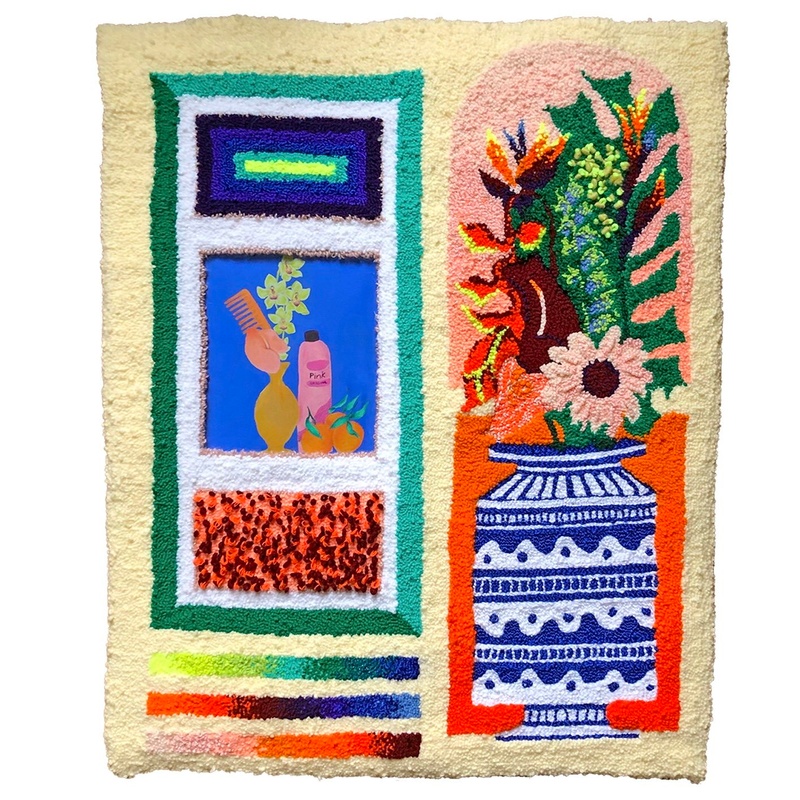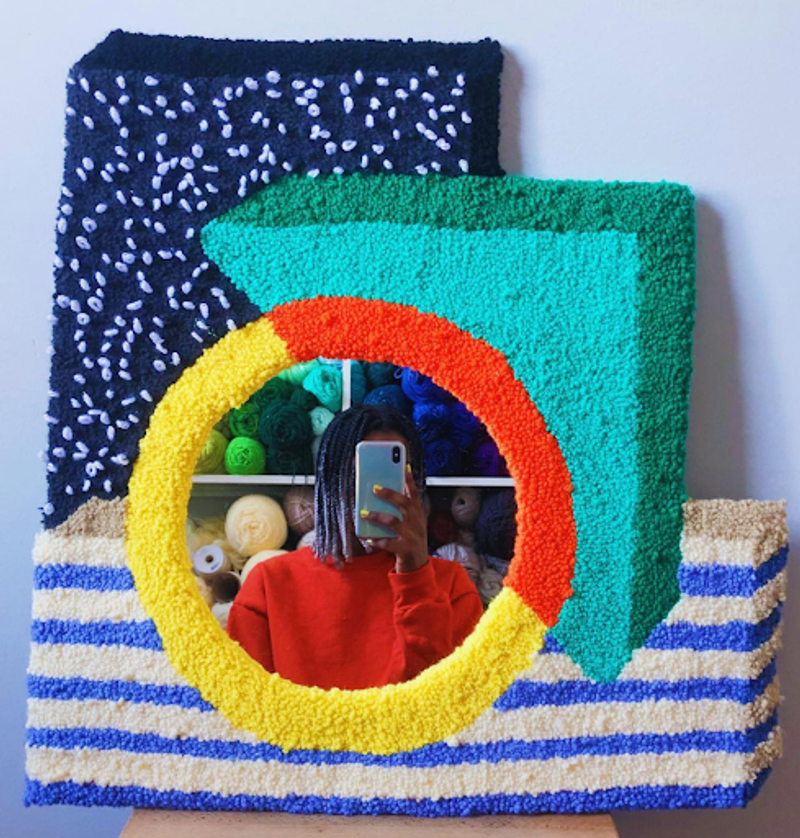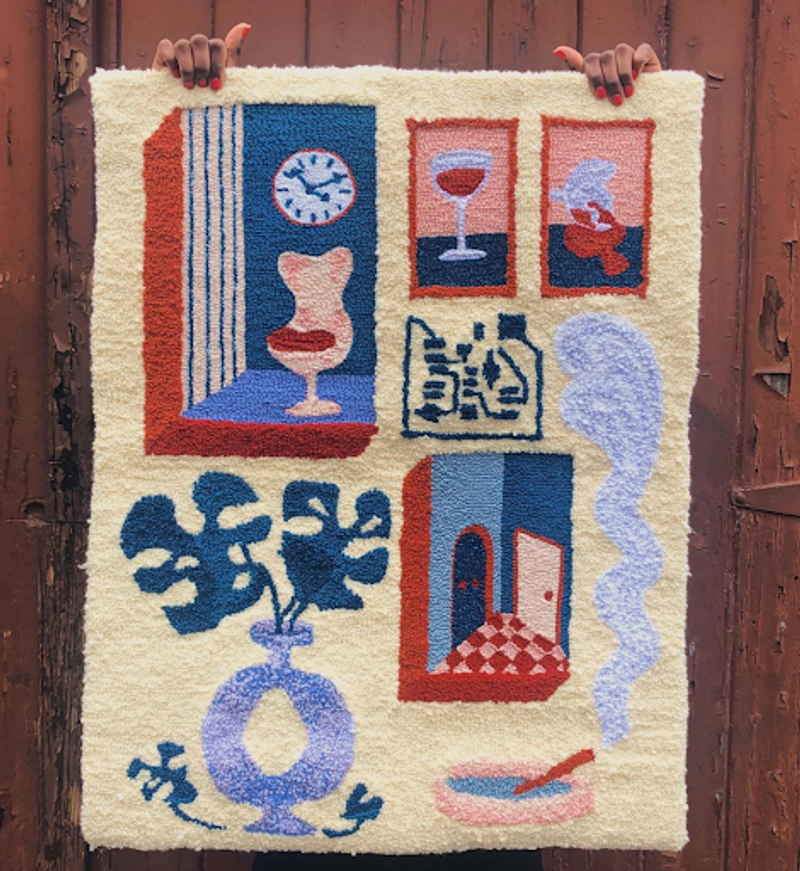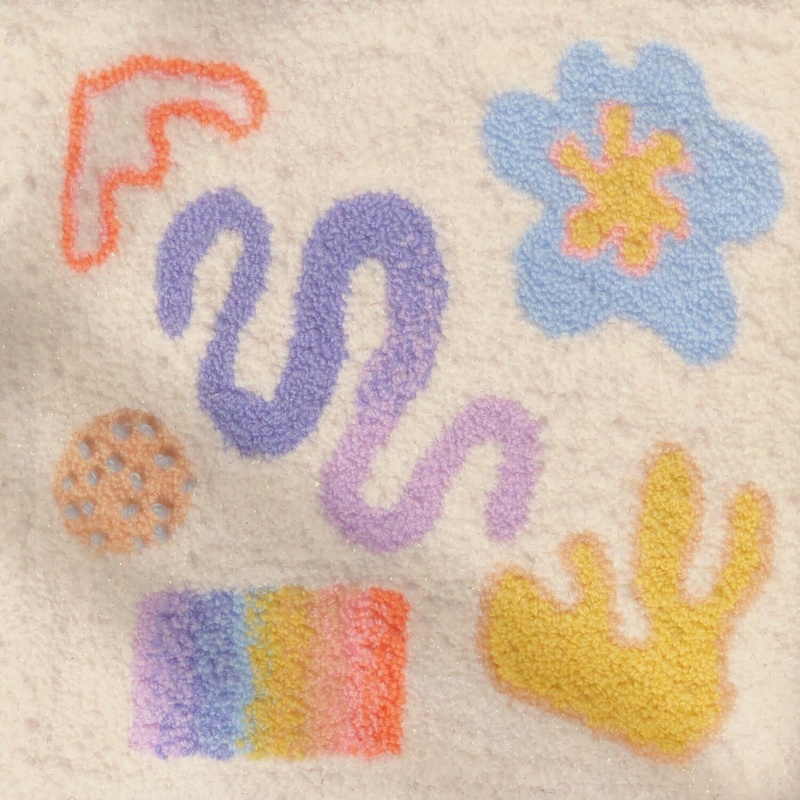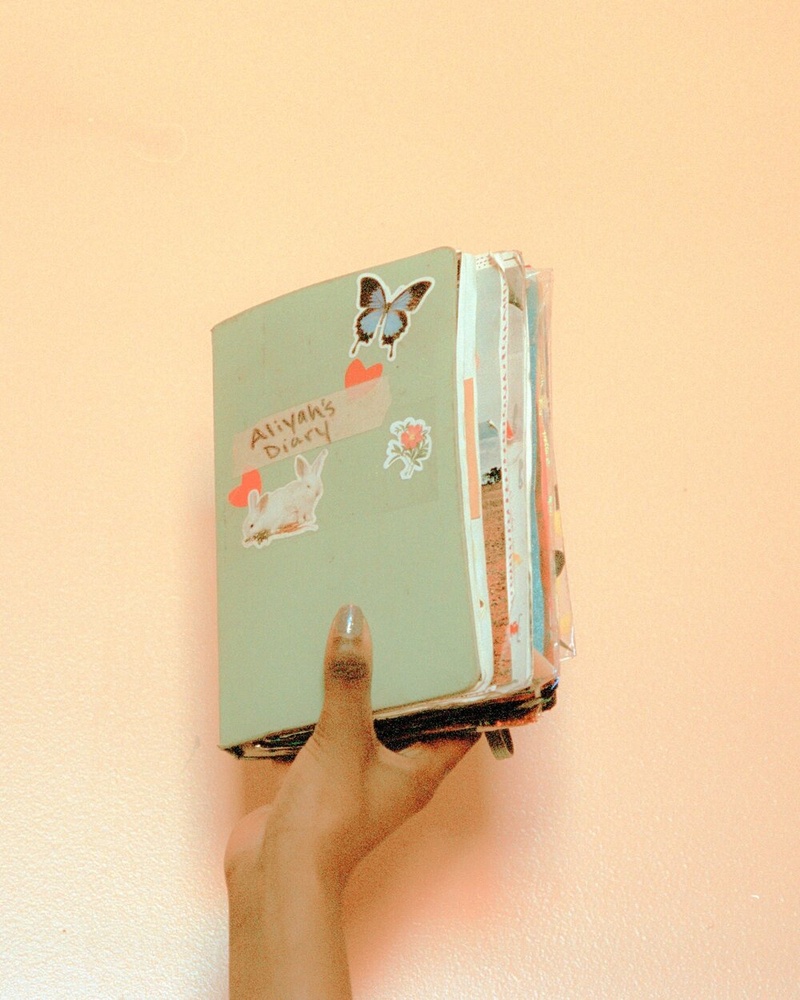You’re an artist who’s done everything from weaving and collage to painting and drawing. How did tufting emerge as your primary medium?
Tufting came from a desire to make work faster and bigger, and still be able to retain the tactile nature of textile art that I can’t get with painting. I consider collage my favorite medium personally, however it’s hard to do that large-scale unless you’re screen printing or have access to facilities. My biggest problem with mediums like weaving and embroidery is they’re very slow crafts, and I love a slow craft—I honestly appreciate it much more than something more fluid and fast—but if you’re trying to make big ideas, if you’re trying to create work with presence, it’s going to take you months. I came about tufting because I knew I didn’t have a loom big enough to do what I wanted to do with yarn, and so this practice came about once I realized the speed at which I could express ideas with a tactile material.
I think it was divine timing that tufting came into my life in late 2019, early 2020. Before the pandemic, I was saving up for a tufting gun, I was saving up for materials, and around the time that I was discovering it a lot of other people were discovering it, too. It just opened up the floodgates for resources, for a lot of different techniques that I had never seen before. It all came together and I had a beautiful time, but I don’t know if I would consider tufting my one true medium. At this stage in my career, I’m really trying to figure out how to incorporate collage, embroidery, multiple ways of working with tufting just to see where else we can take it. I think I’ll always bounce around to different mediums. Tufting’s just my gal right now, you know?
I love this story you’ve told about your first exposure to fiber arts, at a Michaels craft store demonstration in Florida. What do you remember about that experience?
My mom put me in the class when I was seven, maybe a little younger, but it was very clear that I was the youngest person there. And just realizing, “Oh, I’m a small Black child amongst older white women.” I think that was kind of a representation of a lot of my experiences in the craft world.
It’s a dichotomy right now. There’s a whole wave of younger—I want to say contemporary textile artists—who are taking these crafts and making them their own. And then of course there are also traditional textile artists who are hobbyists, who are the ones making your handmaid sweaters and stuff. And I really appreciated and respected those two groups of people in what I do, because there’s so much that we’re learning from each other. It’s so special. I see a lot of older women passing along what they know about these crafts, and it’s beautiful to see the younger kids embracing it, especially the younger boys. I’m seeing a lot of young men embracing textiles.
You’re someone who seems very clear about where you stand in that dichotomy between artist and craftsperson. How do you think about that distinction in relation to your practice?
I never want people to think that I think I’m better than because I only hang my pieces on a wall and I only call myself a fine artist. I think because of what I’m trying to do and where I want to go, I clearly see myself as an artist, but I don’t think everyone has to. I think that the awareness and understanding is that there can be so many things in between artists and craftspeople and making for commerce—there’s room for everybody. And more than anything I would like for the people who want themselves to be considered artists doing this medium to only call themselves artists. You have to almost hammer it into people what you want to be so they will address you as such.
Coming from a studio background, having gone to SCAD, having had the art school experience, I think it would be really easy for me to view this as just my craft and a way to make money or something. But I don’t know. I’ve always wanted to be a fine artist. And I think regardless of the medium, I will be a fine artist. Just because this medium is considered crafty doesn’t take away from what I’m saying.
What does the beginning of your process look like? Do you start with a sketch?
I used to never sketch. I used to just jump straight into everything I did. And then in the past couple of years, I’ve really gotten intense with sketch booking, with preliminary drawing, even with collaging. I want to say there’s always two to three steps before the tufting even starts. I collage sometimes. I’ll have newspaper clippings—I collect a lot of vintage magazines and newspapers—and a lot of the time I’ll take out text, I’ll take out images and I will cut them out and play around with them. Sometimes that gives me composition ideas. Sometimes it gives me color ideas and theme ideas, and then I will draw. I’ll take it into my sketchbook. Sometimes it looks completely divorced from the original thing that inspired the drawing. I will draw with colored pencils. I’ll draw with markers. I’ll draw with a pen. And then after that, I’ll refine some more, I’ll do another drawing. And then I’ll do that one more time.
It’s kind of manic, but I draw everything at least like two to three times before I even take it into tufting, because it is such a laborious medium I want to set myself up to make it as seamless as possible, especially when I’m working large. Once I feel satisfied with the drawing, I will create a black and white outline of that drawing. And then I will do my best to put the drawing onto the fabric that I’m working with, and on both sides, so I have to do a mirror image drawing as well. Then I can choose the colors for the yarn. Sometimes, the colors only get chosen after everything is said and done, and I’m looking at the yarn and I say, “Oh, this is it.” And then we cook.
When it comes to the actual tufting, how many hours on average does it take you to finish a larger piece?
I want to say between 15 to 40 hours per piece. I’ve gotten much better now that I’ve gone freelance and I can spend all of my time working. I block it up into three to five-hour increments of just working straight instead of doing marathon 10-hour days like I used to when I was still working a job. It takes quite a bit of time. And since I primarily use my punch needle, it’s a hand tool, so I’m putting in every single piece of yarn and overseeing every single step.
Do you have a favorite place to work?
I really love sitting at my desk. I have a cozy tulip chair that I’ve just turned into my desk chair, and I have a little footrest. I put my iPad up and watch some 90 Day Fiancé while I’m working. I really try to make myself as comfortable as I possibly can because it is pretty monotonous work. I listen to podcasts, I listen to music, I watch TV. It always helps to have something else going on while doing it, and that’s also the beauty of having so many things planned in advance. It’s kind of just like driving on autopilot.
Does it feel like entering a kind of flow state?
Definitely. My favorite part about textile art, and just the nature of time-consuming work is losing yourself after hours working. I’m really attracted to projects that take a lot of hours and a lot of work. I really love the buildup and the slow release of working on a project day after day after day. And I feel kind of empty once it’s all over. I find it’s easier to put my heart and soul into something if I’m coming back to it for hours and hours at a time. It’s easier to pour your heart into it.
Does the work take a toll on your body?
Yeah. I have nightmares about getting carpal tunnel syndrome one day. It’s my biggest fear right now. I started to take more stretching breaks. It’s definitely something I’m already planning: my exit route from the way I’m working right now. I know one day I’m going to eventually have to make the transition into using my gun, just to preserve my hands, but for now I feel called to this way of working. I don’t know if I’ll be able to work this way five years from now.
It doesn’t feel sustainable?
The only reason why it doesn’t feel sustainable is because I am trying to set myself up to have a very long career and I want to make sure that I preserve my drawing hand for as long as I can. I’ve recently seen tufters complain of arthritis and wrist problems and they have to get anti-vibration gloves and things like that. I’m getting kicked off my insurance in two months. I can’t really afford to fuck myself up too bad.
How do you think about color in relation to your work?
I love color. I would describe it as the most important thing in my life, and not just from an art-making perspective. It just gives me a reason to breathe. It sounds so melodramatic, but without the color and the beauty that color brings me in this life, I don’t know what else there would be. I don’t know if you knew this but I’m blind in one eye. I have a lot of trouble with depth perception and being able to draw accurately, and working with shadow gets kind of confusing for me. And so color is the only crutch I have really been able to rely on when drawing and making. I understand color so well, much more than perspective, much more than anything else.
I think the one good eye I have is just an eye for color and I make color palettes in my spare time. I reorganize things by color for fun. It’s pretty obsessive. I find that tufting allows me to express a lot with color. Even a very simple color palette looks really dynamic with yarn. It’s so different. I feel like I can never really plan for what I want because it just turns out so different every time.
Were you born blind in one eye?
The way that it was described—cataracts run in my family. I was born with a cataract in my left eye and they didn’t find it until I was about six. I started wearing glasses. I started wearing eye patches. I had eye surgery when I was 16 and it did nothing for me, so I just have this eye that can understand color and light, but anything else is just a big blurred image. I can’t make out anything. If I have that kind of vision in both eyes, I’d need help.
It’s given me a very wonky perspective for drawing and for seeing things. Like I can’t drive a car, but I’ve strayed away from hiding it in my art. I used to really overcompensate for my lack of sight by doing incredibly realistic drawings, but now I think it’s what makes some of my work look unique. None of my lines are perfectly straight, and some of my shapes are a little wonky, but at this point that’s just how it’s going to be. There’s a lot more forgiveness in yarn art, I find, that I can’t really find in drawing or painting. It’s been much better for me and my sight.
As a freelance artist, what does your financial pie chart look like?
I’ll be completely honest: I was on unemployment, especially during 2020. 2020 I had no idea that any of this would be possible. I really, in my mind thought, well for the next 10 years, I’m probably going to be serving tables and doing my art on the side, and I would be fine with that. It was obviously not ideal, but after the wave of money that came with unemployment, I had the time to sit down and plan, and more opportunities came. And so alongside the drops I do on my website, I also model part-time. That’s not as frequent as a lot of the other stuff I’m doing, but that’s a side gig.
I was a production intern for Mickalene Thomas over the summer. I’m not afraid to take on some nitty gritty work if needed to provide for myself to make this work. I usually have at least one or two other gigs besides my work going on. I’m under NDA, so I can’t really talk about it, but recently a large corporation believed in my work— I had done freelance work for them in the past—and long story short, they gave me a one time check that was enough to fund me for a year. So that’s what I’m living off of right now. Since then, more opportunities like that have come up for me. And so quite literally, this month is the first month where I feel like it’s financially possible for me to live.
That’s huge. Can you talk a little bit about maintaining a visual diary? I’m curious what that practice does for you artistically, emotionally, aesthetically.
Oh yeah, so I have a series called Aliyah’s Diary. I have about four of them that are filled with collages, sketches, remnants of older pieces. It feels almost as textured and tactile as some of my textile work, just in a book format. And once I started doing it more regularly it opened up the door to being able to use my narrative drawing skills more. It just made me feel comfortable expressing myself in this private space, and it’s kind of let out into everything that we have now. I’ve been working that way for the past couple of years, I want to say since like 2017, 2018, consistently in journals and sketchbooks and in my diaries. It’s my life now. Like I have anywhere between two to three sketchbooks going on at any time of different things. It’s so important to have a space that you can share with others if you want to, but it can be completely independent of everything else you’re doing in your practice to get those ideas out, to have it, and just have it be a reflection of what you’re thinking, where you are, the ideas that you’re playing with. It feels like the root of everything I’m doing. And it keeps me really grounded. I’m a huge advocate for sketchbooks, whether it be for things like this or even just a written diary with illustrations in it sometimes— to have that kind of space for you to land in. I love it so much.
You’ve spoken about your struggles with depression, specifically after graduating from college, and how dabbling in psychedelics helped guide you through those slumps. Do those experiences with drugs feel integral to your practice?
I’m not a huge advocate of experimenting with drugs if you don’t know what you’re doing, but I’m an advocate of experimenting with drugs [laughs]. And I think that it’s totally helpful if you have an intention. Even if you don’t, I think just having something in the back of your mind that you want to explore, or you want to know about yourself going into it is helpful.
I smoke weed all the time. I’m always experimenting, I think, with some kind of mind altering something, just for funsies, because it’s just a hard world we live in. I don’t drink. I’m not a party gal. I’m playing with my yarn in my studio all day, so what else am I going to do? [laughs] At this point, I really think there’s something that can be said about being able to escape inside your own mind, to play with yourself in that way, that really helps you as an artist. I don’t think it’s for everyone. But for me, I really enjoy that part of working. I think having fun makes me a better artist, 100 percent, and being able to explore deeper parts of myself is positive for my work. I don’t really dabble in psychedelics anymore. I had a really bad experience during the pandemic with one trip and I’ve kind of put it aside for now. But it has really helped me, and really pulled me out of depression. I’m so thankful for that.
Have you found other ways to help you move through those periods of stuckness?
Success. [laughs] Your girl has been quite happy since things have been popping off. No honestly, work has really been the one thing that keeps me grounded and keeps me focused. I feel as though, I don’t know if purpose is the best way to put it, but just working towards something that I’m really focused on and being disciplined about it really helps take me out of a depressed mindset. Having something tangible that I can see I’m working towards finishing really lifts me up.
This is the happiest I think I’ve ever been in my life. I know I’m young, but I feel an overwhelming amount of happiness every day since I’ve been working on my stuff full time. I feel so annoying when people ask me “How are you?” and I just want to say, “I’m so good right now.” Just knowing that this makes me happy and I get to do it every day has been really helping me keep myself together. I keep it to myself a lot because there’s so much suffering going on in the world right now. The only thing I want to do is spread this joy that I’m feeling inside through my work.
Aliyah Salmon Recommends:
The color chartreuse
Going Native EP by Summer Salt
Soup for breakfast
Dancing around your studio for one hour each day
Filing your daily life with as much color as you can
This content originally appeared on The Creative Independent and was authored by Mitchell Kuga.
Mitchell Kuga | Radio Free (2022-03-07T08:00:00+00:00) Textile artist Aliyah Salmon on creative work as a pathway to joy. Retrieved from https://www.radiofree.org/2022/03/07/textile-artist-aliyah-salmon-on-creative-work-as-a-pathway-to-joy/
Please log in to upload a file.
There are no updates yet.
Click the Upload button above to add an update.
